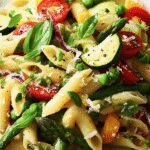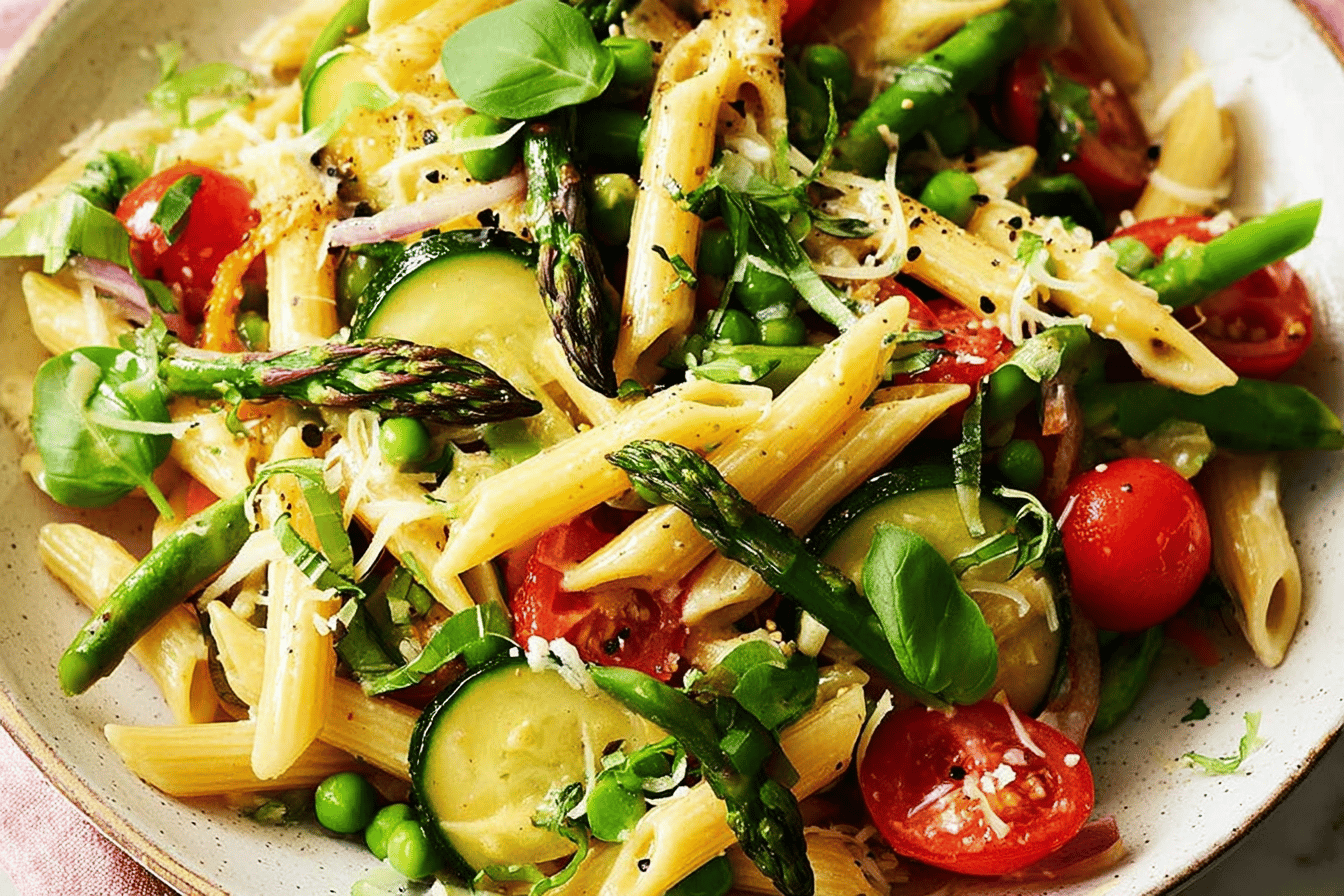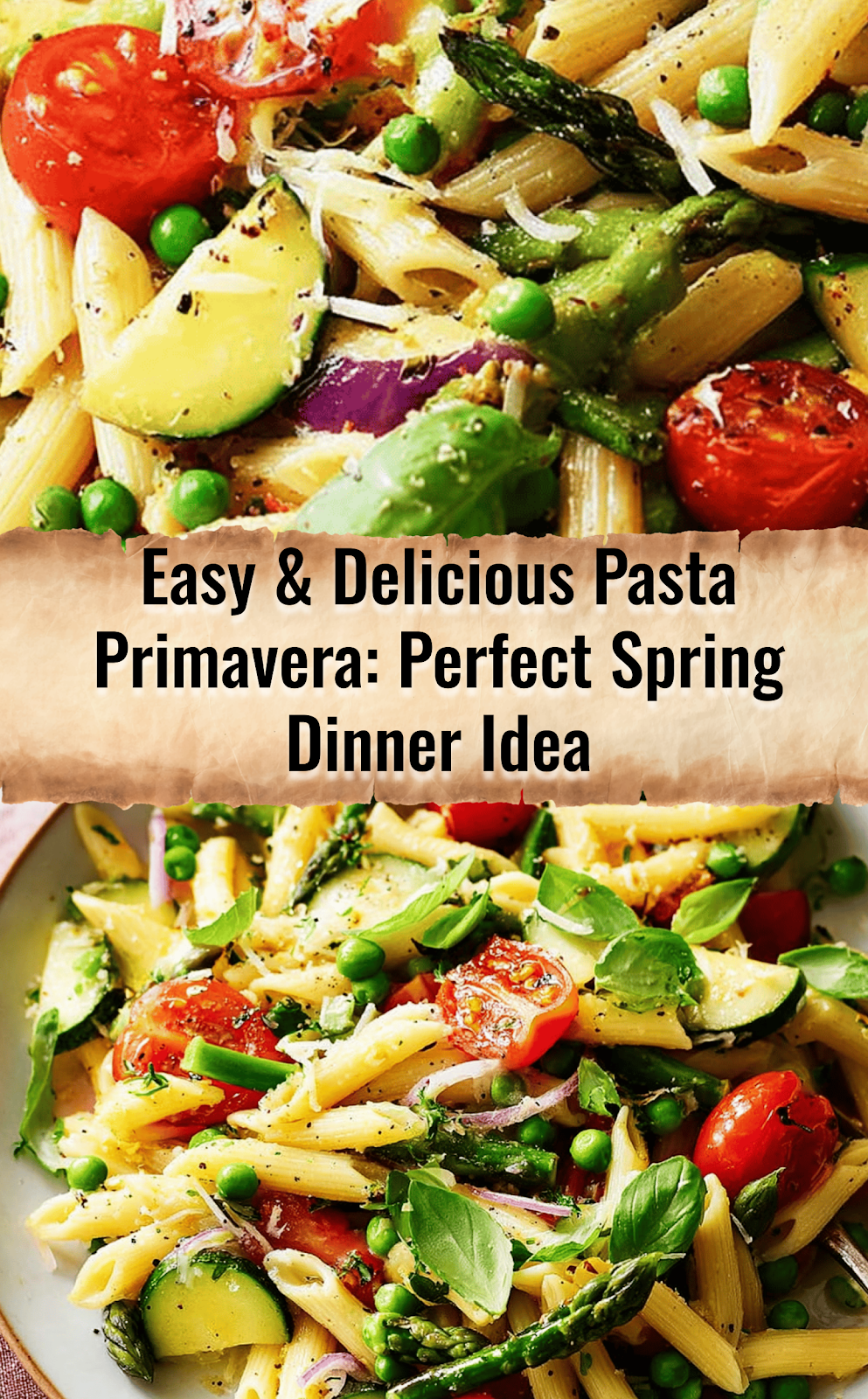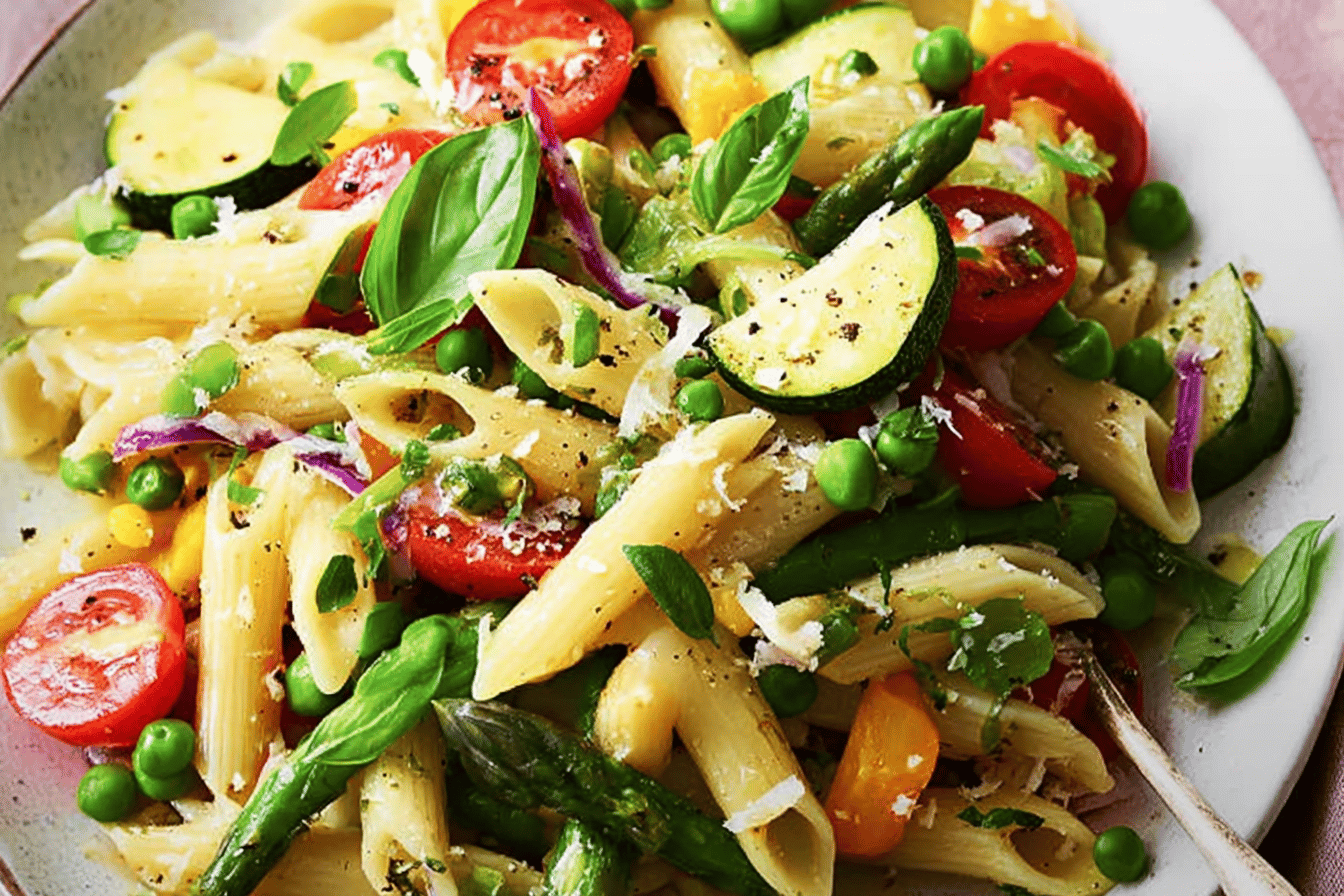Introduction
Cooking has always been a way to connect with memories and the people we love. Growing up, there was this comforting rhythm watching family gather around the kitchen, sharing stories while stirring pots and chopping veggies. Those moments became the heart of every dish, and Pasta Primavera is no exception. It’s not just about fresh pasta and colorful vegetables; it’s about honoring the simple joys and little traditions passed down through generations. Sometimes the sauce might be a tad too salty or the pasta a touch overcooked—but that’s part of the charm, a reminder that cooking is human, imperfect, and deeply personal. This dish brings vibrant flavors and warmth to the table, making it perfect for any day you want to feel a little extra close to home. Print
Pasta Primavera
- Total Time: 40 minutes
- Yield: 6 people
Description
Pasta Primavera is a light and refreshing Italian-American dish featuring pasta tossed with a variety of fresh, colorful vegetables. It highlights the natural flavors of seasonal produce, often accompanied by a delicate sauce that enhances the dish without overpowering it. This recipe is known for its vibrant appearance and balanced combination of textures, making it a popular choice for a healthy and satisfying meal
Ingredients
10 ounces penne pasta
2 tablespoons extra-virgin olive oil, plus more for drizzling
4 garlic cloves, sliced
1 yellow squash, sliced into thin half-moons
1 zucchini, sliced into thin half-moons
1 bunch asparagus, chopped into 1-inch pieces
1 cup cherry tomatoes, halved
1 cup thinly sliced red onion
1 teaspoon sea salt
½ cup frozen peas, thawed
¾ cup grated pecorino cheese
3 tablespoons fresh lemon juice
Red pepper flakes
1 cup fresh basil leaves, plus more for garnish
¼ cup fresh tarragon, optional
Freshly ground black pepper
Instructions
Bring a large pot of salted water to a boil. Cook the pasta according to the package instructions until al dente. Drain and toss with a drizzle of olive oil to prevent sticking.
Heat the olive oil in a large, deep skillet over medium heat. Add the sliced garlic, yellow squash, zucchini, asparagus, cherry tomatoes, red onion, sea salt, and several grinds of black pepper. Sauté for 3 to 4 minutes until the vegetables are tender.
Add the cooked pasta, thawed peas, grated pecorino cheese, fresh lemon juice, and a pinch of red pepper flakes. Toss everything together to combine. Stir in the fresh basil and tarragon if using.
Adjust seasoning to taste, garnish with additional basil leaves, and serve.
Notes
Make sure to use fresh vegetables for the best flavor
Avoid overcooking pasta to keep it firm
Toss pasta and sauce immediately to blend flavors
Use a large pan to prevent overcrowding the veggies
Season gradually to balance taste perfectly
- Prep Time: 30
- Cook Time: 10
Preparing time
10 minutesCooking time
15 minutesIngredients and measurement
10 ounces penne pasta 2 tablespoons extra-virgin olive oil, plus more for drizzling 4 garlic cloves, sliced 1 yellow squash, sliced into thin half-moons 1 zucchini, sliced into thin half-moons 1 bunch asparagus, chopped into 1-inch pieces 1 cup cherry tomatoes, halved 1 cup thinly sliced red onion 1 teaspoon sea salt ½ cup frozen peas, thawed ¾ cup grated pecorino cheese 3 tablespoons fresh lemon juice Red pepper flakes 1 cup fresh basil leaves, plus more for garnish ¼ cup fresh tarragon, optional Freshly ground black pepperInstructions
Cook the pasta
Bring a large pot of salted water to a boil. Cook the penne pasta until al dente, following the package instructions. Drain the pasta and toss it lightly with a drizzle of olive oil to keep it from sticking together.Sauté the vegetables
Heat 2 tablespoons of extra-virgin olive oil in a large, deep skillet over medium heat. Add the sliced garlic, yellow squash, zucchini, asparagus, halved cherry tomatoes, sliced red onion, sea salt, and a few grinds of freshly ground black pepper. Stir and cook for 3 to 4 minutes until the vegetables soften and release their lovely aroma.Combine pasta and other ingredients
Add the cooked pasta to the pan along with the thawed peas, grated pecorino cheese, fresh lemon juice, and a pinch of red pepper flakes. Toss everything gently so all the flavors mingle and the cheese slightly melts into the warm pasta.Finish with fresh herbs and seasoning
Stir in the fresh basil leaves and tarragon if using. Taste and adjust seasoning with extra salt, pepper, or red pepper flakes if you like a bit more kick.Serve and garnish
Transfer to plates, drizzle with a little more olive oil, and garnish with extra basil leaves. Serve warm and enjoy the burst of freshness and bright colors on your plate!Notes
Vegetable swaps
Feel free to swap asparagus for green beans or add bell peppers if you have them on hand. It’s all about what’s fresh and available!Cheese alternatives
If pecorino isn’t your thing, parmesan works just fine—just use a good-quality one for best flavor.Mild heat
Red pepper flakes add a nice touch of warmth but don’t overwhelm the dish. Start with a pinch—you can always add more later!Make it ahead
This pasta is best eaten fresh but you can store leftovers in the fridge. Reheat gently with a splash of water or olive oil to keep it moist.
Cooking tips :
Preventing pasta from sticking
After draining your penne, toss it right away with a little extra-virgin olive oil. I’ve lost count of the times I forgot this step and ended up with a big sticky mess. A quick drizzle keeps the pasta loose and ready to mingle with those fresh veggies without clumping together.Sautéing vegetables evenly
Make sure to slice your squash and zucchini into thin half-moons so they cook quickly and evenly. Throw them in once your garlic fragrant, and keep the heat medium—not too hot! I once charred my garlic within seconds, which gave the dish an unintended smoky twist no one asked for.Balancing flavors with lemon and cheese
Fresh lemon juice is a total game-changer here, brightening up the whole dish and cutting through the richness of pecorino. I usually squeeze it a little at a time, tasting as I go, because sometimes you want zing, sometimes you just want a gentle kiss of acidity.Adding fresh herbs last
Toss in your basil and optional tarragon right at the end off the heat to keep their vibrant flavor intact. Adding them too early can make them lose their punch, which is such a bummer after carefully chopping.Cooking tips :
Using frozen peas
Frozen peas, once thawed, add a sweet little pop without any extra cooking. I don’t bother heating them separately—just toss them in with the pasta and veggies. Saves time and clean-up, which is always a win.FAQ
Can I use dried herbs instead of fresh?
You can, but fresh herbs bring a brightness that dried ones just can’t match here. If you must, add dried tarragon and basil early in cooking to allow the flavors to develop.What if I don’t have pecorino cheese?
Parmesan is a fine stand-in, but pecorino gives that nice salty, tangy kick that really lifts this dish.Can I use other vegetables?
Absolutely! Feel free to swap in what you have on hand—bell peppers, snap peas, or even spinach all work well. Just adjust cooking times accordingly.Is this dish good served cold?
It’s best warm or at room temperature—chilling can dull the lemon and herb flavors that make it so fresh and vibrant. But hey, leftovers still taste great the next day!Conclusion
This vibrant penne pasta dish is such a simple, joyful way to celebrate fresh veggies and bright flavors all tossed together in one pan. The way the garlic and lemon juice lift the earthy zucchini, squash, and asparagus is honestly a little magical, especially when that pecorino cheese melts in just right. Sometimes when I rush, the garlic gets a bit crispy or I overcook a veggie or two—but honestly, those happy little “flaws” just add some extra character, and it still tastes comforting every time. It’s perfect for a weeknight dinner when you want something quick but still feel like you’re eating something special and fresh from the kitchen garden. I love how the basil and tarragon bring that unexpected pop of herbal freshness, making this dish feel bright and cozy all at once.Suggestions of another similar recipes
Spring Vegetable Orzo Salad with Lemon and Herbs
Try swapping penne for orzo and tossing your spring veggies with a lemony vinaigrette. It’s great chilled too, perfect for leftovers or picnic lunches.Garlic and Herb Farro with Roasted Cherry Tomatoes
Farro’s nutty flavor pairs perfectly with roasted tomatoes and fresh herbs like basil and tarragon, for a chewy, satisfying grain bowl.Summer Squash and Zucchini Frittata
If you have extra zucchini and squash lying around, a simple frittata with those veggies plus fresh basil and pecorino makes for a cozy breakfast or light dinner.Lemon Basil Pesto Pasta with Peas and Asparagus
Whip up a fresh basil pesto with lemon juice and olive oil, then toss it with pasta, peas, and asparagus for a burst of flavor that’s easy to make on a busy night.

